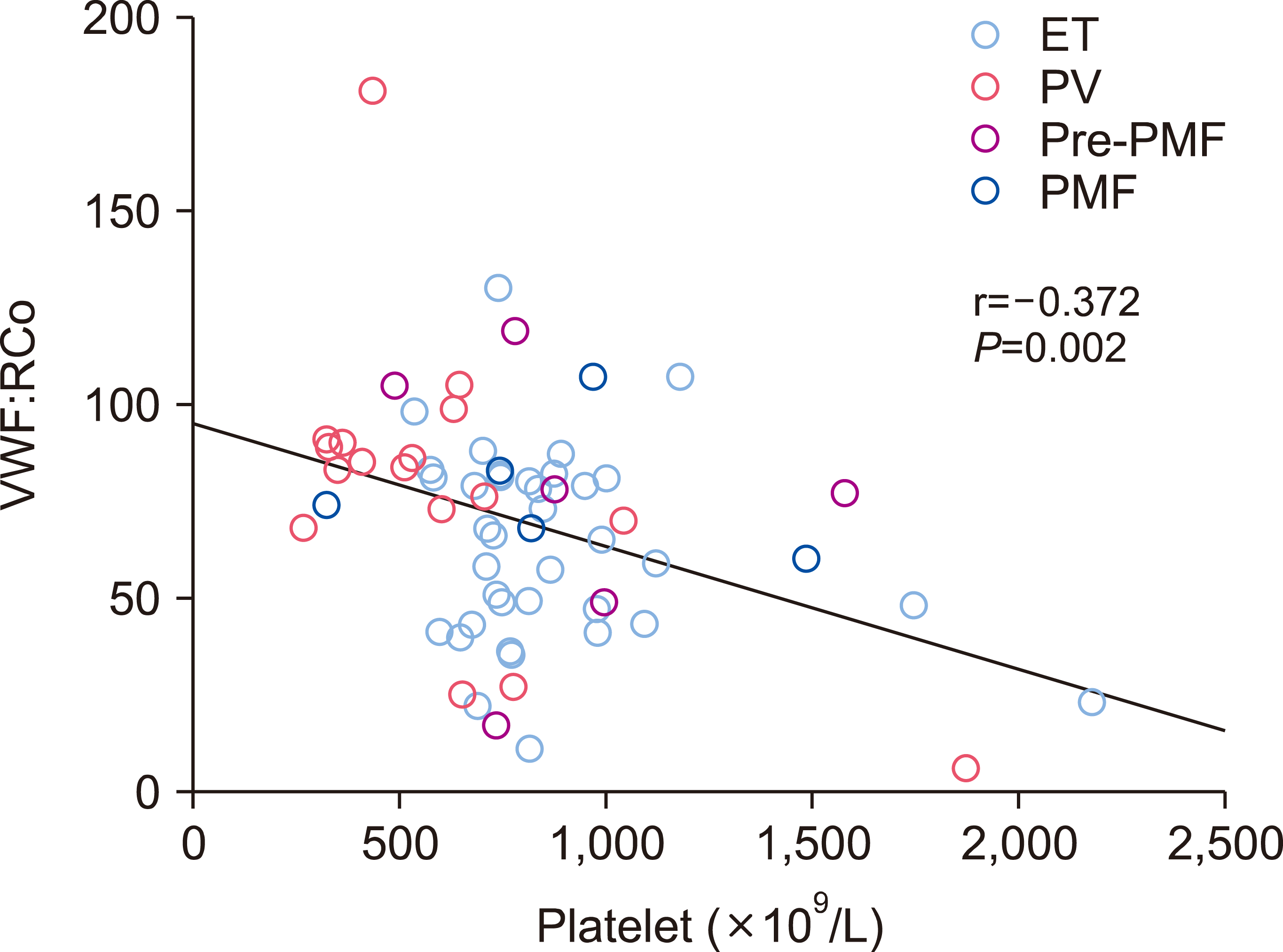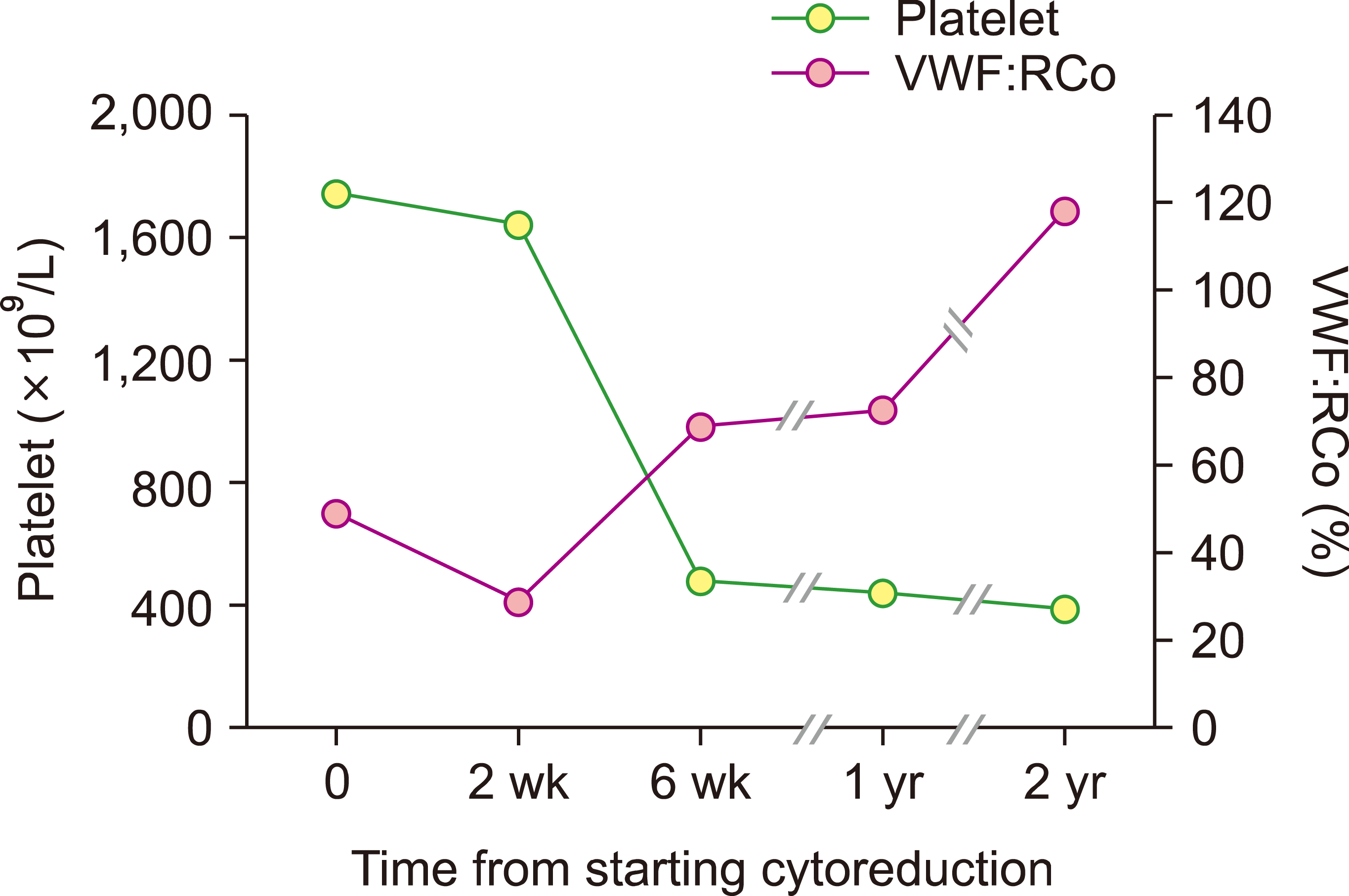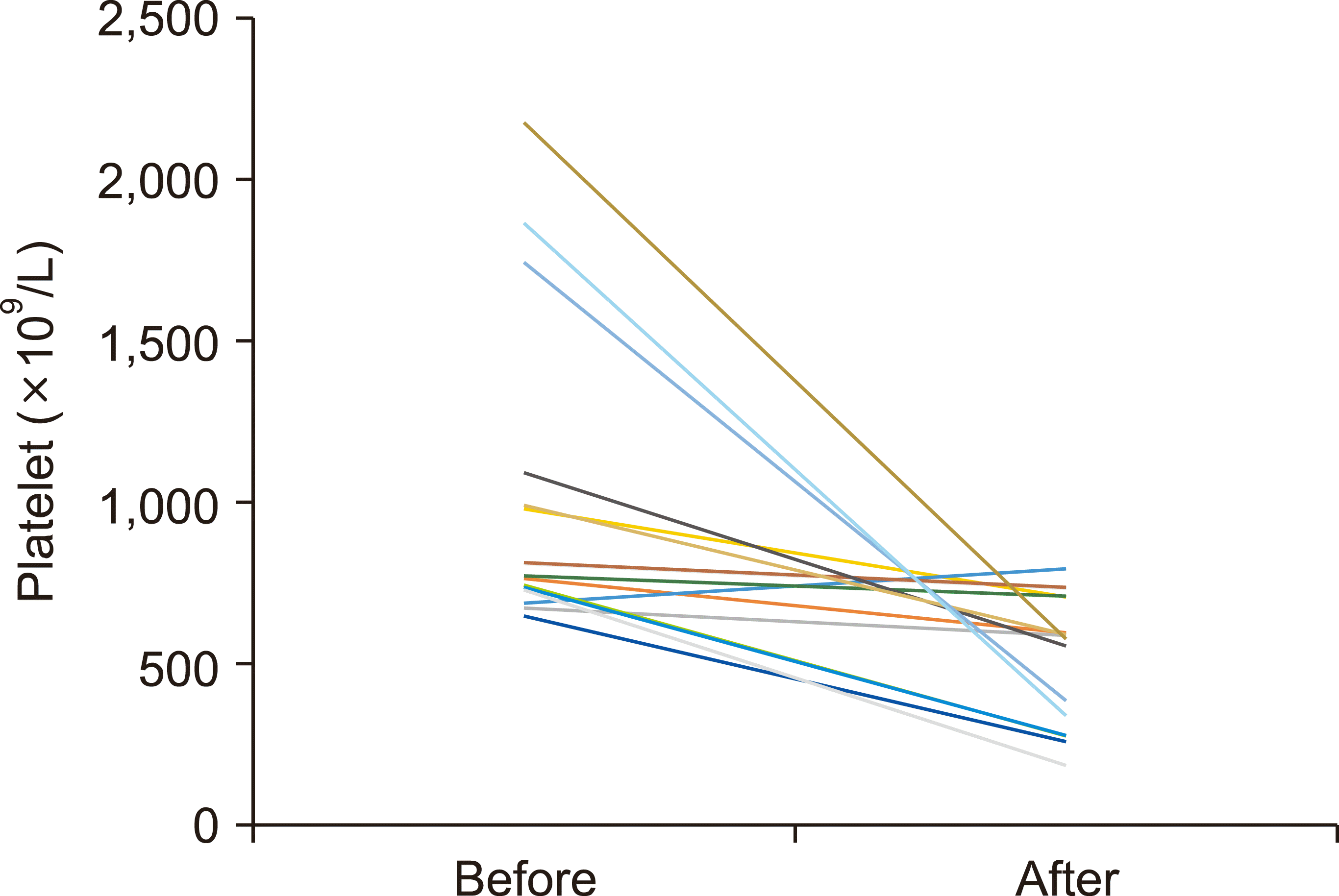2. Song IC, Yeon SH, Lee MW, et al. 2022; Myelofibrotic and leukemic transformation in 2016 WHO-defined Philadelphia-negative myeloproliferative neoplasm. Blood Res. 57:59–68. DOI:
10.5045/br.2021.2021209. PMID:
35256550. PMCID:
PMC8958372.

3. van Genderen PJ, Leenknegt H, Michiels JJ, Budde U. 1996; Acquired von Willebrand disease in myeloproliferative disorders. Leuk Lymphoma. 22(Suppl 1):79–82. DOI:
10.3109/10428199609074364. PMID:
8951776.

6. Biguzzi E, Siboni SM, Peyvandi F. 2020; How I treat gastrointestinal bleeding in congenital and acquired von Willebrand disease. Blood. 136:1125–33. DOI:
10.1182/blood.2019003702. PMID:
32584960.

8. Koren-Michowitz M, Lavi N, Ellis MH, Vannucchi AM, Mesa R, Harrison CN. 2017; Management of extreme thrombocytosis in myeloproliferative neoplasms: an international physician survey. Ann Hematol. 96:87–92. DOI:
10.1007/s00277-016-2826-4. PMID:
27734130.

9. Choi KS, Kim JM, Ryu JI, Oh YH. 2015; Concurrent ruptured pseudoaneurysm of the internal carotid artery and cerebral infarction as an initial manifestation of polycythemia vera. J Korean Neurosurg Soc. 58:137–40. DOI:
10.3340/jkns.2015.58.2.137. PMID:
26361530. PMCID:
PMC4564746.

12. Lim Y, Lee JO, Bang SM. 2016; Incidence, survival and prevalence statistics of classical myeloproliferative neoplasm in Korea. J Korean Med Sci. 31:1579–85. DOI:
10.3346/jkms.2016.31.10.1579. PMID:
27550486. PMCID:
PMC4999400.

13. Byun JM, Kim YJ, Youk T, Yang JJ, Yoo J, Park TS. 2017; Real world epidemiology of myeloproliferative neoplasms: a population based study in Korea 2004-2013. Ann Hematol. 96:373–81. DOI:
10.1007/s00277-016-2902-9. PMID:
28028559.

14. Passamonti F, Thiele J, Girodon F, et al. 2012; A prognostic model to predict survival in 867 World Health Organization-defined essential thrombocythemia at diagnosis: a study by the International Working Group on Myelofibrosis Research and Treatment. Blood. 120:1197–201. DOI:
10.1182/blood-2012-01-403279. PMID:
22740446.

15. Cervantes F, Dupriez B, Pereira A, et al. 2009; New prognostic scoring system for primary myelofibrosis based on a study of the International Working Group for Myelofibrosis Research and Treatment. Blood. 113:2895–901. DOI:
10.1182/blood-2008-07-170449. PMID:
18988864.

16. Mital A, Prejzner W, Świątkowska-Stodulska R, Hellmann A. 2015; Factors predisposing to acquired von Willebrand syndrome during the course of polycythemia vera - retrospective analysis of 142 consecutive cases. Thromb Res. 136:754–7. DOI:
10.1016/j.thromres.2015.07.029. PMID:
26269222.

17. Rottenstreich A, Kleinstern G, Krichevsky S, Varon D, Lavie D, Kalish Y. 2017; Factors related to the development of acquired von Willebrand syndrome in patients with essential thrombocythemia and polycythemia vera. Eur J Intern Med. 41:49–54. DOI:
10.1016/j.ejim.2016.11.011. PMID:
27919526.

18. Lee MW, Yeon SH, Ryu H, et al. 2021; Volumetric splenomegaly in patients with essential thrombocythemia and prefibrotic/early primary myelofibrosis. Int J Hematol. 114:35–43. DOI:
10.1007/s12185-021-03121-x. PMID:
33704663.

20. Kander EM, Raza S, Zhou Z, et al. 2015; Bleeding complications in BCR-ABL negative myeloproliferative neoplasms: prevalence, type, and risk factors in a single-center cohort. Int J Hematol. 102:587–93. DOI:
10.1007/s12185-015-1871-4. PMID:
26440973.

21. Lancellotti S, Dragani A, Ranalli P, et al. 2015; Qualitative and quantitative modifications of von Willebrand factor in patients with essential thrombocythemia and controlled platelet count. J Thromb Haemost. 13:1226–37. DOI:
10.1111/jth.12967. PMID:
25876231.

22. Nitu-Whalley IC, Lee CA, Griffioen A, Jenkins PV, Pasi KJ. 2000; Type 1 von Willebrand disease - a clinical retrospective study of the diagnosis, the influence of the ABO blood group and the role of the bleeding history. Br J Haematol. 108:259–64. DOI:
10.1046/j.1365-2141.2000.01830.x. PMID:
10691852.

23. Goyal J, Reddy VV, Marques MB. 2013; Acquired von Willebrand's disease in myelofibrosis and essential thrombocythemia. Haemophilia. 19:e256–7. DOI:
10.1111/hae.12152. PMID:
23590694.

24. Adam R, Priglinger M, Harrington T, Gottlieb D, Krause M. 2014; An unusual cause of cerebellar hemorrhage in a young patient: essential thrombocythemia. J Stroke Cerebrovasc Dis. 23:e373–4. DOI:
10.1016/j.jstrokecerebrovasdis.2013.12.013. PMID:
24582788.

25. Rupa-Matysek J, Lewandowski K, Lewandowska M, et al. 2015; Bleeding complications after arthroscopy in a JAK2V617F- positive patient with essential thrombocythemia and acquired von Willebrand syndrome (AVWS). Int J Hematol. 101:405–10. DOI:
10.1007/s12185-014-1707-7. PMID:
25432436.

26. Kanderi T, Puthenpura M, Shrimanker I, Sapna F, Felter SC. 2020; Triple-negative essential thrombocythemia complicated by thrombosis and acquired von Willebrand disease in a young man. Am J Case Rep. 21:e924560. DOI:
10.12659/AJCR.924560.

27. Tefferi A, Szuber N, Pardanani A, et al. 2021; Extreme thrombocytosis in low-risk essential thrombocythemia: retrospective review of vascular events and treatment strategies. Am J Hematol. 96:E182–4. DOI:
10.1002/ajh.26137. PMID:
33617676.

28. Budde U, van Genderen PJ. 1997; Acquired von Willebrand disease in patients with high platelet counts. Semin Thromb Hemost. 23:425–31. DOI:
10.1055/s-2007-996119. PMID:
9387201.

29. Tefferi A, Barbui T. 2020; Polycythemia vera and essential thrombo-cythemia: 2021 update on diagnosis, risk-stratification and management. Am J Hematol. 95:1599–613. DOI:
10.1002/ajh.26008. PMID:
32974939.

30. Tatewaki W, Takahashi H, Shibata A. 1988; Multimeric composition of plasma von Willebrand factor in chronic myeloproliferative disorders. Clin Lab Haematol. 10:417–25. DOI:
10.1111/j.1365-2257.1988.tb01190.x. PMID:
3150698.

31. Tatewaki W, Shibata A. 1989; Acquired von Willebrand disease in patients with chronic myeloproliferative disorders. Leuk Lymphoma. 1:51–7. DOI:
10.3109/10428198909042459. PMID:
27456408.

32. Kubo M, Sakai K, Hayakawa M, et al. 2022; Increased cleavage of von Willebrand factor by ADAMTS13 may contribute strongly to acquired von Willebrand syndrome development in patients with essential thrombocythemia. J Thromb Haemost. 20:1589–98. DOI:
10.1111/jth.15717. PMID:
35352474.

33. Barbui T, Tefferi A, Vannucchi AM, et al. 2018; Philadelphia chromosome-negative classical myeloproliferative neoplasms: revised management recommendations from European LeukemiaNet. Leukemia. 32:1057–69. DOI:
10.1038/s41375-018-0077-1. PMID:
29515238. PMCID:
PMC5986069.

34. Tefferi A, Smock KJ, Divgi AB. 2010; Polycythemia vera-associated acquired von Willebrand syndrome despite near-normal platelet count. Am J Hematol. 85:545. DOI:
10.1002/ajh.21730. PMID:
20575028.

35. Michiels JJ, Berneman Z, Schroyens W, Finazzi G, Budde U, van Vliet HH. 2006; The paradox of platelet activation and impaired function: platelet-von Willebrand factor interactions, and the etiology of thrombotic and hemorrhagic manifestations in essential thrombocythemia and polycythemia vera. Semin Thromb Hemost. 32:589–604. DOI:
10.1055/s-2006-949664. PMID:
16977569.








 PDF
PDF Citation
Citation Print
Print


 XML Download
XML Download